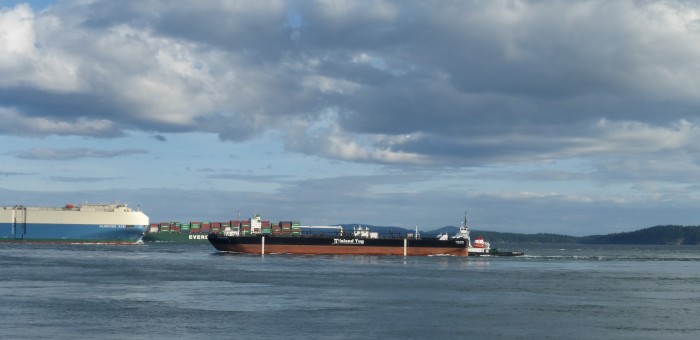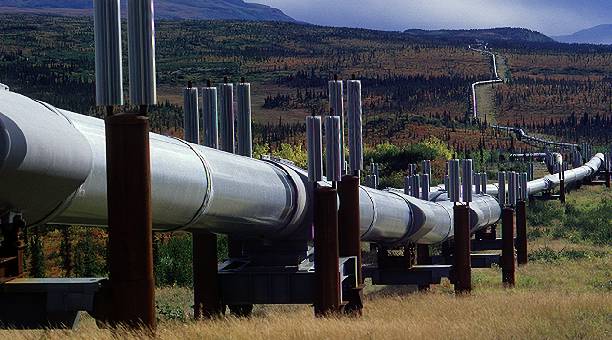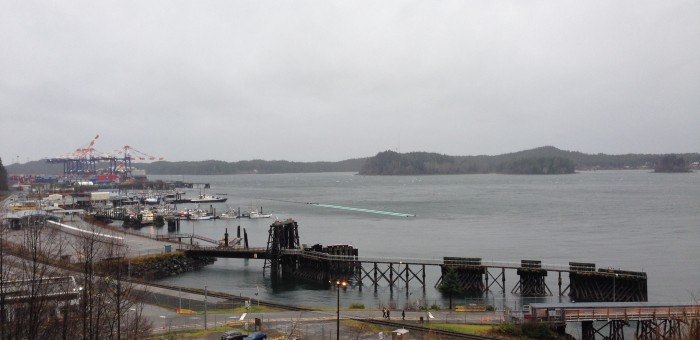Kinder Morgan’s Disappointing Answers
This post is part of an ongoing series in which MLA Andrew Weaver will be sharing key information from inside the National Energy Board hearings on Kinder Morgan’s Trans Mountain pipeline proposal.
In recent weeks there has been widespread news coverage concerning the disappointing and incomplete answers Trans Mountain provided many intervenors when asked about their pipeline proposal.
Back in May, my team and I spent countless hours poring over the 15,000 page application, dissecting Kinder Morgan’s claims and evaluating their evidence. For a small office like mine, that is a big commitment. Yet we gave it the due diligence it deserved because my constituents, and British Columbians across the province, have been clear: They are concerned about the prospect of substantially increasing heavy oil tanker traffic on our coast and they expect their MLAs to do something about it.
Collectively, intervenors submitted more than 10,000 questions to Trans Mountain. Of these, I submitted nearly 500. Unfortunately, the answers we received failed to address many of the questions I, and other intervenors, asked.
To give you a sense of what I mean, let me offer an example.
Geological and Geographic Factors
One of the biggest concerns for south island residents is the risk of an oil spill. In reviewing the oil tanker route analysis, I found that, surprisingly, the section on “Geographic and Geological Factors” along the route was only three sentences long. This was surprising because geographic and geological factors—such as islands and rocky shorelines—often play a role in incidents that lead to oil spills. Not only that, but according to the Federal Tanker Safety Expert Panel the route these tankers would take is a “very high risk” area.
Here’s that entire section on “Geographic and Geological Factors”:
“The Southern coast of British Columbia has a wide range of geographic and geological formations. The proposed waterways have a variety of Sandy to rocky shore lines and scattered with islands, coves, and inlets. The proposed route is deep and wide enough and currently providing safe transit for vessels similar to the project vessels to and from Vancouver harbour.”
While I appreciate that ships already transit the area, this fact, on its own, does not provide an adequate assessment of risk along the route. I therefore asked Kinder Morgan to elaborate on this section and to provide a more complete assessment of geographic and geological factors that could contribute to an oil spill.
Unfortunately, Kinder Morgan’s response was to simply refer to me the very section I asked them to elaborate on. If I still wanted more information, they then suggested I “refer to the appropriate navigation chart”.
Challenging these Answers
I find this answer highly disappointing. Unfortunately, it is also typical of many of the answers we received.
If Kinder Morgan is truly trying to earn the social license to build this project and ship additional oil through our coastal waters, I think it is fair to require them to have a more detailed assessment of the islands and geological formations that make up the route they will use.
Let me be clear: My concern, at this stage, is not about receiving answers that I disagree with. We received many answers that I believe British Columbians will be concerned about—but at least in those cases we received answers.
My concern here is that Kinder Morgan is refusing to provide actual answers to important questions.
The Province of British Columbia, the City of Burnaby, the City of Vancouver and many other intervenors have all voiced this same concern.
These questions form the basis of the entire hearing process. This is where we get to test the validity of Trans Mountain’s evidence so that in the end the National Energy Board can make a fully informed decision about whether the pipeline should be approved or not.
The fact is that given the massive outpouring of opposition to the Northern Gateway pipeline and the serious concerns that have been raised about heavy oil spills, it is hard to believe that Kinder Morgan would not be doing everything possible to address the concerns of intervenors and of all British Columbians.
New Timeline for Kinder Morgan Hearings Creates Opportunity for Oral Cross-Examination
Media Statement: July 15, 2014
Weaver says NEB timeline extension creates opportunity for oral cross-examination
For Immediate Release
The National Energy Board’s extended timeline for Kinder Morgan’s Trans Mountain pipeline hearings offers a perfect opportunity to introduce oral cross-examination into the hearing process, according to Andrew Weaver, MLA for Oak Bay-Gordon Head and Deputy Leader of the B.C. Green Party.
The National Energy Board announced today that it has revised its timeline for the pipeline hearings. The new timeline will put the regular hearing process on hold for three months while Trans Mountain files supplementary information on its new pipeline corridor through the City of Burnaby.
“I support the three month extension so that the necessary information on the new route can be tabled and reviewed by the NEB and by intervenors,” says Andrew Weaver, who himself is an intervenor in the hearing process.
This three-month extension would have put the NEB’s final deadline to submit its recommendations to the Federal Cabinet right in the middle of next October’s Federal election. However, the timeline has been further extended by an added four months, pushing the decision until January 2016.
Extending the timeline for the Trans Mountain Hearing Process was debated earlier this year, when Andrew Weaver supported a motion that requested that the NEB include oral cross-examination as part of the Hearing Process.
Oral cross examination was crucial to uncovering gaps in Enbridge’s evidence during the NEB hearings on the Northern Gateway Pipeline. Unfortunately, the NEB rejected the motion on the grounds that they had to meet a legislated timeline for reviewing this project.
“Given that an extension has been granted so that new evidence can be brought forward, I hope the board will reconsider its decision on oral cross-examination,” said Weaver. “There is no replacement for questioning Trans Mountain’s evidence in person, particularly in light of the inadequate written responses that Kinder Morgan has been providing to intervenors.”
“If the Board is willing to extend the timeline so new information can be introduced by Trans Mountain, I would hope they would consider using the extended timeline so that something as essential as oral cross-examination could be introduced to test company’s evidence,” said Weaver.
Andrew Weaver is the only B.C. MLA with intervenor status in the hearings.
-30-
Media Contact
Mat Wright – Press Secretary, Andrew Weaver MLA
1 250 216 3382
Jumbo Glacier Resort: Undermined By Science
With a recent Supreme Court decision in place, the year-round ski resort on Jumbo Glacier is one step closer to development. If built, the resort will be the first of its kind in North America. It will also likely be the last of its kind, ever, because at a fundamental level, it simply does not make sense.
If fully completed, the 20-year, billion-dollar development is expected to be the only resort in North America where patrons will be able to ski year-round. The project has been hotly contested since its inception 23 years ago. Throughout this period, it has faced significant local opposition from special interest groups, local communities, and First Nations. Most recently the Ktunaxa First Nations brought the resort before the BC Supreme Court, arguing that its development violated a sacred area for the Ktunaxa Nation. The court has now ruled in favour of the developer, removing one more barrier to the resort’s construction.
But does this development make sense?
Development happens, change happens, and there will always be proponents and opponents of specific projects. Yet, in the case of the Jumbo Glacier Resort, there are a few facts that appear to undermine the viability of the project.
First, the science is clear: The whole concept of a long-term, all-season ski resort is slowly but surely becoming a fantasy. Glaciers across BC are melting and Jumbo Glacier is no exception. It is expected that by 2100, Jumbo Glacier will be largely non-existent. In fact, just looking at the period between 1985 and 2005, the entire Southeastern BC glacial region lost, on average, roughly 15% of its mass. Yet while the science is forecasting increased melting, according to the developer’s own plan it will still take over 20 years to build the proposed resort. This means that by the time the resort is fully operational a further 20 years of melting will have also occurred. The fact is, climate change is eliminating the viability of year-round glacial skiing and as it does so, it is turning Jumbo Resort into an increasingly risky investment.
Second, the Jumbo Resort clearly lacks a social license to continue. Over the last decade, media, governing bodies and special interest groups have conducted several polls and surveys that serve to highlight the significant local opposition to this project. For example, in the 2004 Environmental Assessment over 90% of the thousands of comments received were in opposition to the project. There has been significant local opposition to the idea of the resort from its inception and there continues to be strong opposition from the Ktunaxa First Nation.
Finally, the fact that the provincial government has used $250,000 to create a municipality that has no residents and no infrastructure is troublesome, given the real needs that exist in our province. How this is a good use of taxpayer money or a sound investment decision are both good questions.
Until this week, Jumbo Resort had a deadline to begin construction by this fall, or it would have to undergo a new environmental assessment. Unfortunately, the provincial cabinet passed an order in council this week that may exempt Jumbo Resort from undergoing this assessment. This change is particularly troublesome given the advancements in climate science and in our knowledge of glacier melting, both of which have evolved significantly since Jumbo underwent its last environmental assessment in 2004.
The fact is, the more we learn about glacier science, the less a resort like Jumbo makes sense. Given this, it’s hard to understand why the provincial government is subsidizing and promoting the development of a project that faces significant local opposition and flies in the face of our best scientific understanding of climatic trends.
Twenty years ago we may have thought this project had a promising future. Now we know that future is bleak.
What Leadership Looks Like on Thermal Coal Exports
By 2016, B.C. will have doubled its thermal coal exports. Thermal coal is largely sourced from outside of British Columbia and contributes very little to B.C. jobs. It is also one of the single largest contributors to global carbon emissions. In fact, the increase in B.C.’s thermal coal exports that we will see in the next two years alone will produce more carbon emissions than our entire province will in 2020, assuming we meet our legislated climate targets.
Last fall, the BC government joined the Pacific Coast Action Plan on Climate and Energy. Together with Washington, Oregon, and California, we committed to building a strategic alignment to combat climate change and promote clean energy. Our partners understand the threat of thermal coal and have taken practical steps to reduce their thermal coal exports. It’s time B.C. did the same.
State Leadership on a National Issue
Recognizing that they have limited power within their jurisdiction the leaders of California, Oregon and Washington are putting pressure on the American federal government to halt the expansion of coal exports. For instance, the Governors of Oregon and Washington have pressured the Obama administration to review the impact that leasing and exporting western coal has on climate change. A letter signed by both governors states: “We cannot seriously take the position in international and national policymaking that we are a leader in controlling greenhouse gas emissions without also examining how we will use and price the world’s largest proven coal reserves.” Furthermore the governors believe that “the decisions to continue and expand coal leasing from federal lands and authorize the export of that coal are likely to lead to long-term investments in coal generation in Asia, with air quality and climate impacts in the United States that dwarf those of almost any other action the federal government could take in the foreseeable future”.
Similarly, in 2012, the Assembly and Senate of the State of California passed a resolution urging the American President and Congress to “enact legislation to restrict the transshipment for waterborne export of coal for electricity generation to any nation that fails to adopt rules and regulations on the emissions of greenhouse gases”. This resolution easily passed in California.
Practical Steps that Make a Difference
Meanwhile, these states are also taking practical steps within their jurisdiction to halt the expansion of coal exports. For example, a few weeks ago the Port of Oakland board of commissioners in California unanimously rejected two proposals that would have seen the construction of a new coal export facility, citing environmental concerns, public health hazards, economic pitfalls, and public opposition. This is the most recent rejection of proposed coal export facilities on the west coast; three other coal export facilities have been rejected in Oregon and Washington over the last two years.
Another great example of leadership is found in Washington. There the Department of Ecology is now requiring, as part of its environmental impact statement on the proposed Gateway Pacific Terminal (a massive coal export facility), “an evaluation of impacts associated with the project from greenhouse gas emissions including those from terminal construction, terminal operation, rail and vessel traffic, and also the end-use coal combustion”. This is a holistic approach to environmental assessments as it recognizes that building the coal-export facility does not only have local environmental impacts but will also facilitate the increased use of burning coal in Asia, and thus increase the emissions going into our global atmosphere.
It’s Time for B.C. to Step Up
Elected officials in these U.S. states clearly understand the threat thermal coal poses to our climate and they are doing what they can to respond. Our provincial government could do the same. Instead we remain the only administration in this partnership that has not spoken out against the export of thermal coal. In fact, when I proposed a motion in February to limit the expansion of U.S.-sourced thermal coal exports it was voted down 73 to 1. This is shameful.
Exporting increased amounts of thermal coal is a direct threat to the progress we have made on addressing climate change. Local and state leaders in California, Oregon, and Washington recognize that exporting coal to be burned in Asia undermines their attempts to reduce their own emissions. The same is true for B.C. It’s time we follow their leadership and stop the expansion of thermal coal exports.
To understand more about how BC ports are expanding their coal-export operations and why I am opposed, please read my three previous blogs on the issue, found here, here and here.
If you are interested in my motion to reduce the expansion of thermal coal exports, you can read my speech here.
Debrief: Town Hall on Island Health’s new Patient care Model
Last night I held a public Town Hall on Island Health’s new Patient Care Model. According to Island Health, the new model (titled Care Delivery Model Redesign, or CDMR), will shift from a nurse-centered approach to a team-centered approach that will see an increased role for health care aids. Under the model, Island Health will be cutting 100 baseline nursing positions in 21 units at the Royal Jubilee and Victoria General Hospitals and replacing these positions with 95 new baseline Health Care Aid position.
According to Island Health the model (titled Care Delivery Model Redesign, or CDMR) will address strains on the health care system while increasing the care time a patient receives. However, critics have argued that it could put patients at risk as nurses are replaced with health care aids that are inadequately trained for their new role.
Many constituents wrote me with their concerns about the patient care model. In response, I met with key stakeholders including Island Health, the BC Nurses Union and the College of Registered Nurses of British Columbia.
What became clear is that while Island Health states that the new patient care model is evidence-based, they have yet to release their evidence for public review. Meanwhile, health care research clearly suggests that the new model could have significant implications on the quality of care a patient receives.
The purpose of the town hall was to bring together the different perspectives so that we could become informed about this change to our health care system.
I was pleased that our panel could include:
- Dr. Noreen Frisch, Professor and Director of the UVic School of Nursing
- Dr. Paddy Rodney, Board Member of the Association of Registered Nurses of BC and Professor at the UBC School of Nursing
- Adriane Gear, South Island Co-Chair at the BC Nurses Union
- Sara Shorten, Representative of the UVic Nursing Student Society
Island Health was invited but unfortunately chose not to participate.
In December, I wrote to Dr. Brendan Carr, President and CEO of Island Health and requested that further implementation of the new patient care model be paused until comprehensive, independent and publically-available evaluations can be completed. I also requested that key stakeholders, such as BC’s Registered Nurses and Licensed Practical Nurses be further involved in these evaluations and in developing any plans involving the realignment of care teams.
I will continue to voice these concerns in the coming weeks and encourage constituents to raise their voices as well.








